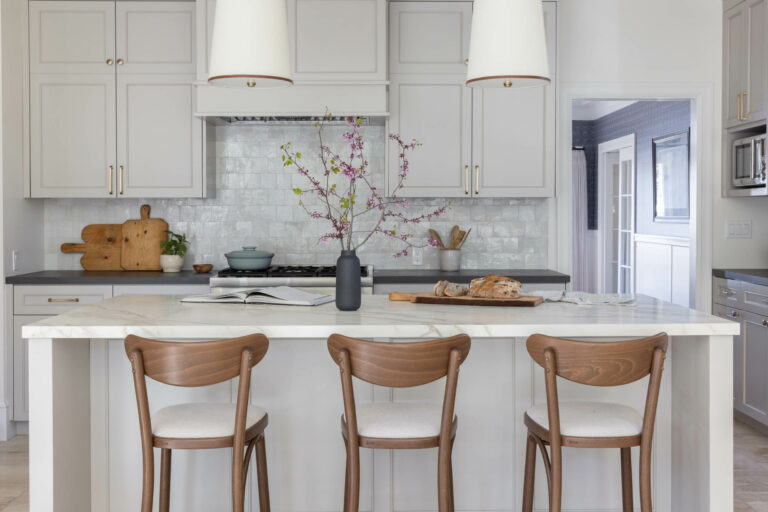Book a Complimentary Discovery Call
Speak with our Principal Interior Designer, Dana Feagles.
Tell us about your project, your needs, your hurdles, and your aspirations.
Learn how we can help.
Cabinet hardware is one of those things that you can spend a ton of money on, OR you can shop wisely, do your research, and get perfectly good hardware for less. But do you know how to choose cabinet hardware? What sizes do you need? Does the finish need to match your faucet? Do you need pulls, bars, or knobs?
It’s confusing, I know. I’m here to help!
Cabinet hardware – that is, the hardware on the face of the cabinetry used to open doors and drawers (I’m not talking about hinges or drawer gliders in this post) – should be made of a solid material with a rust-resistant finish.
The highest quality hardware is solid bronze. Bronze is naturally corrosion-resistant with anti-microbial properties, and requires very little maintenance.
Solid brass and stainless steel are also widely used and excellent options.
If the style of your kitchen calls for it, glass and crystal are also excellent options.
Stay away from aluminum, plastic, and wood kitchen cabinet hardware if you can. Aluminum tends to corrode from acids like vinegar, tomato and lemon juice, and the plating process gives aluminum hardware a plastic-like, cheap appearance. Plastic hardware is not durable enough to withstand years of pulling. Wood hardware will stain and is not a good choice for a kitchen where messy hands are unavoidable. I definitely recommend avoiding painted wood hardware in a kitchen – eventually the paint will chip, and then you have paint chips on your hands and in your food.

Aesthetically, it’s important to consider the overall style of your kitchen, bathroom, office, or wherever your cabinets are going. A contemporary kitchen may have hidden edge pulls, while a traditional kitchen has the design foundation for more traditional hardware such as crystal or ornately-designed bronze. Always consider the overall style you’re going for and choose your hardware accordingly. Do not mix styles of hardware, and do not put contemporary hardware in a more traditional space.
The finish of your cabinet hardware does NOT need to match your faucet finish, your pendant finish, your door knob finish, your window sash finish, etc. This is a design myth that I am busting right now!
Mixing metals can create a warm, layered, and storied look in your home. The trick, however, is to mix metals that are in line with the overall style of your kitchen. If you have a traditional kitchen, avoid chrome faucets and chrome hardware. Mixing an aged brass faucet with dark bronze hardware, or vice versa, is a lovely combination.
For a more classical look, mixing polished nickel with polished brass is perfectly acceptable. For more modern kitchens, a chrome faucet may be mixed with either bronze, brass, stainless, or nickel hardware, as long as you keep the upper and lower hardware finishes consistent.
Choosing the proper hardware size seems tricky, but you will always be safe with a knob around 1 inch diameter for a standard size door or drawer. Anything larger than 1.5” diameter should be used on full-height doors, such as on a pantry cabinet. You may find some knobs as large as 2.75” diameter – these are typically used on heavy doors, such as a mirrored closet door.
In a more traditional kitchen, upper and lower cabinetry typically use only knobs or small pulls (under 4 inches in length). A modern kitchen typically uses a mix of knobs and longer pulls, or it can feature all pulls and no knobs.
I like to use matching knobs on the upper cabinet doors and on the lower drawers, paired with vertical pulls of varying lengths on the lower cabinet doors. This ensures your eye always has somewhere to look, as every cabinet will essentially look different, while maintaining continuity through the finish and style.
Drawers are more nuanced, as you have to consider the width as well as the depth of the drawer. The pull should be no longer than one-third the width of the door or drawer, especially if you have a lot of cabinets. The longer and larger the hardware, the busier your kitchen will look. If you have a wide, deep drawer for pots and pans, for example, you will be better served with a horizontal pull at least 7 inches long, rather than 2 knobs, due to the weight of the drawer. A standard-size utensil drawer will typically be fine with either 1 knob, or 1 horizontal 4- to 5-inch pull.
Sun Valley Bronze: designer-quality and pricey, but solid bronze construction that will survive longer than your kitchen will. Their Mushroom knob is one of my go-to’s.
School House: solid brass construction in an array of modern and functional styles. Their Edgecliff pull is wildly popular among designers.
DeVol: my go-to for a warm and cozy kitchen. Solid brass construction in tasteful traditional styles. I love pairing their Heirloom Brass Pull Handles with their Cupboard Catches.
If you need help selecting your cabinet hardware and making your home feel more functional, cohesive, and stylish, reach out to us at hello@revelryinteriordesign.com or book a free consultation with us here.
Cheers,
Dana Feagles, Principal Interior Designer
Speak with our Principal Interior Designer, Dana Feagles.
Tell us about your project, your needs, your hurdles, and your aspirations.
Learn how we can help.